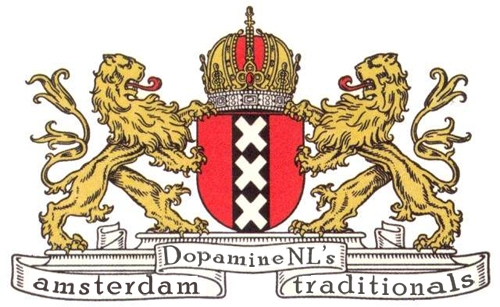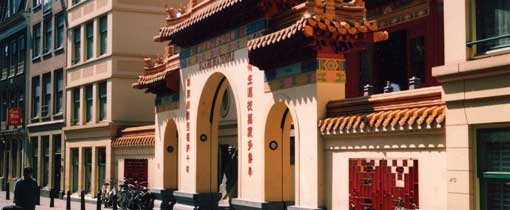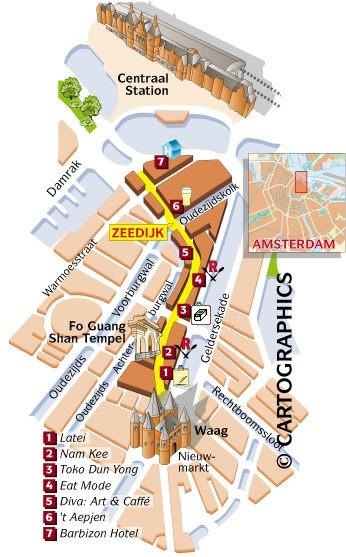 |
Welcome to Amsterdam!
City of charming canals, lovely parks and cheap entertainment. And of course: lots of geocaches! Although we are not as endowed as many other European or American cities, we do have our share of interesting caches for visitors from abroad. But beware: the Dutch love their micros, multis and mysteries!
|

|
 |
Chinatown
From Prins Hendrikkade to the Nieuwmarkt, the Zeedijk is the beating heart of Amsterdam’s Chinatown. The 'zee dijk' used to be the actual old ‘sea dike’ that protected medieval Amsterdam from the waves. Hence, everything north and east of here is newly reclaimed land. It was a sailor's hangout for centuries, with infamous bars like ‘Cafe in ’t Aepjen’ (for the Dutch: this is the origin of the saying: “in de aap gelogeerd”). In the 1970s and 1980s the Zeedijk was a notorious nogo-area filled with drugs and crime. Since the 1990s it has been cleaned up (with much help of the local entrepreneurs) and is yet again a very popular (young) tourist spot. It borders the Red Light District, but is not part of it as there is no (official) prostitution here.

The first part of the Zeedijk, before the curve (coming from the north), is a nightlife area, mixing tourists with the local gay community (check out the Hartjesdagen, every third weekend of august!). But continue south and one can see and feel the street changing into a more oriental atmosphere: tokos and (asian) restaurants abound, and many windows have Chinese characters on them. At the far end you will find Europe’s biggest Buddhist temple. Opened in 2000 by Queen Beatrix, The Fo Guang Shan He Hua Temple is open tue-sun, 12-17hr, and does tours.
Amsterdam’s Chinatown started around the Binnen Bantammerstraat (one street south of the cache), but gradually moved towards the Zeedijk, starting when Toko Dun Yong was the first to open shop there. While Amsterdam’s Chinatown is the second-oldest in Europe (bar London), the Chinese are actually moving out, towards more family friendly neighbourhoods in the northern and eastern suburbs.
|
 |
History
The first Chinese came to The Netherlands at the end of the 19th century on ships that sailed between Europe and the Dutch East Indies. The first big wave of Chinese immigrants (from Guangdong) came in 1911, when Dutch shipping companies brought them over from England in order to break the big strike of Dutch sailors. By the 1930s Chinese peanut-sellers had become a well-known phenomenon in the streets of Amsterdam.
Even though much literature on Chinatown makes it seem like the Chinese somehow naturally ‘settled down’ there, it was actually the Dutch who confined them to the area around the Binnen Bantammerstraat, by setting up boarding houses here. After the strike, shipping companies kept the Chinese ‘on hold’ in the boarding houses as cheap workers. Although they did get 70 percent of what a Dutch sailor would get paid, 90 percent of their earnings went back to the shipping master, who was also the holder of the boarding house. Exploited, and without legal status or support, the Chinese in Amsterdam were living in poverty. Next to selling peanuts, smuggling opium and weapons was an essential source of income to them.
|
 |
 |
Crime
In the 1960s Chinese businesses started to flourish. In 1966 there were 83 Chinese restaurants in Amsterdam, especially around the Binnen Bantammerstraat. But there were also many gambling houses and opium dens. In the 1970s heroin was introduced, just before the independence of Suriname and the subsequent influx of refugees to Amsterdam. This unfortunate conjuncture created a large group of Surinamese drug users and dealers (working for Chinese drugs and arms traders), and turned Chinatown into a nogo-area. Many unsuspecting tourists arriving at Central Station walked right into this street-trap, coming out the other end with nothing but their underwear!
It was eventually the American DEA (Drugs Enforcement Agency) who helped Amsterdam unravel the world behind the restaurants: three triads, named 14K, Wo Lee Kwan, and Wo Sing Wo, were battling over the heroine that came into Amsterdam. Chung Mon, a seemingly small-time owner of a restaurant and a travel agency, was in fact leader of the 14K and controlled most of the heroin trade in Amsterdam. When he was killed in 1975 thousands of Chinese from all over Europe came to pay him their last respects.
Although the area has been completely cleaned up nowadays, new problems do occasionally arise. For example the recent restricting of windows in the Red Light District has caused a large increase in 'traditional' Chinese or Thai massage parlours, many of which are fronts for illegal prostitution.
|
Points of interest
There are a lot of interesting locations in Chinatown that you can see. Check out the additional waypoints of this cache and the image to the right.
Used sources:
- an interesting (partly philosophical) essay on Amsterdam's Chinatown (quoted fragmentally here) can be found on Manya Koetse's site
- Martrix, a site on taoism with nice pictures of Chinatown, but no English
- www.zeedijk.nl
- And of course Wikipedia
Also check out:
The cache
The Zeedijk is a horrible place for a cache (far too busy), but Chinatown's original location makes for a quiet enough caching spot.
|
 |
Personal note by Elmeraculous
When De Muis - also on behalf of Stickman_76 - contacted me whether I was interested in adopting this cache (originally placed by DopamineNL) I was very excited. This was mainly because I have lived at the Zeedijk around the corner from the cache for 3 years together with my wife (nr 82A). And our oldest daughter was actually born there. So I didn't have to think twice about my answer. Also funny to mention: when I went to check the status of the cache after Stickman_76 and De Muis contacted me, I noticed the wooden container itself had been used as a logbook and the first name I spotted on there was my own; written in there in 2018. I then remembered that at that time the logbook was missing and some people had been writing on the inside of the wooden box to be able to log it anyway. I figured that was pretty clever thinking and followed their example. Some would argue I never signed an actual logbook and thus had no right to log a 'Found it' online. Well, that has now been straightened out as well as I had to change my 'Found it' log to a 'Write note' in order for it to show up on the map as a cache of my own instead of a smiley.
After finishing the adoption process (of the cache, not my daughter) in July 2022 I have made some small changes to the listing. The original title was 'Amsterdam Trad's - Chinatown' because it used to be part of a series of traditional caches that all bared the same prefix in the title. As all the other caches in this series had been archived and this being the only one left, the prefix in the title didn't make a whole lot of sense anymore and perhaps made people wonder where the other Amsterdam trad's had gone (well in fact, you can find them in this list). So I changed the cache's name to 'Amsterdam's Chinatown'. Furthermore I removed some sections that were kind of outdated and created more of a distraction than necessary. A big thanks to DopamineNL for creating it and to Stickman_76 and De Muis for maintaining it for so many years. I will make sure to take care of it as well as they did. Enjoy!
PS. A great and proud moment: on April 7th 2024 Amsterdam's Chinatown became the most found Geocache in The Netherlands. In honor of this fact we held a nice little event next to the cache.
|